Understanding Golf Terms: A Beginner’s Guide
Posted by

Playing golf can feel like entering a maze of unfamiliar terms, especially when you’re just starting out. But don’t worry—understanding golf terminology is actually not that complicated, and it’ll help you build confidence on the course.
Golf isn’t just about hitting a ball; it’s a sport with its own language. Once you get a handle on these terms, you’ll find yourself communicating better, following the rules with ease, and enjoying the game even more.
This guide breaks down the basics of golf terminology in simple, easy-to-understand language. Whether you’re a beginner or just looking for golf lessons to polish your skills, we’ve got you covered.
Introduction to Golf Terminology
Stepping onto a golf course for the first time can be exciting—but let’s be honest, it can also be a bit intimidating. The lush green fairways, the challenge of the game, and the flood of unfamiliar terms can leave you feeling unsure.
But don’t stress—it’s all part of the process! Learning the language of golf is your first step toward feeling right at home on the course.
At Skillest, we’ve seen that students who take the time to learn golf terminology progress faster. By making the language of golf easier to understand, we’re helping beginners build a strong foundation for their game.
Whether you’re picking up a golf club for the first time or refining your technique, this guide will help you get started and set you on the path to success.
Basic Golf Terms Every Beginner Should Know
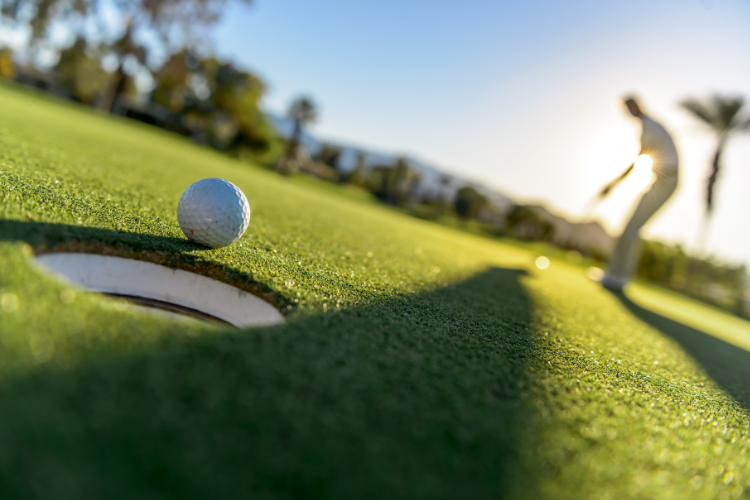
Getting familiar with basic golf terms is a game-changer for anyone just starting out. These essential terms are the building blocks of golf’s language and pop up regularly in play, lessons, and conversations with fellow golfers.
Common Scoring Terms
Understanding how scoring works is super important for enjoying golf and tracking your progress.
These are the key terms that help players stay on top of their performance:
Par:
The number of strokes a skilled golfer is expected to take on a hole or course. Each hole has a par rating—usually 3, 4, or 5—based on its length and difficulty. Par serves as the benchmark for your performance.
Birdie:
One stroke under par on a hole. For example, if you finish a par-four hole in three strokes, you’ve got a birdie. It’s a sign of solid play and a goal that many golfers aim for on every hole.
Bogey:
One stroke over par on a hole. So, if you take five strokes to finish a par-four hole, that’s a bogey. Bogeys happen, especially for beginners, but they give you something to improve on.
Eagle:
Two strokes under par on a hole. For instance, completing a par-five hole in three strokes is an eagle. Eagles are rare and a real sign of skill.
Double Bogey:
Two strokes over par. If you complete a par-three hole in five strokes, that’s a double bogey. While not ideal, it’s important to stay positive and focus on the next hole.
Hole-in-One:
Also known as an ace, it happens when the golf ball goes directly into the hole on the first stroke, typically on a par-three hole. This is a rare, unforgettable moment that every golfer dreams of.
Getting the hang of these scoring terms not only helps you track your performance but also gives you a clearer goal to work toward as you play.
Types of Golf Shots

Every situation on the course calls for a different type of shot.
Knowing these terms helps you strategize and play smarter:
Drive:
A long-distance shot from the tee box, usually with a driver. This sets you up for the next shot and can have a big impact on your overall score.
Putt:
A short stroke made on the green to roll the ball into the hole. Putting is all about precision—getting the speed and break of the green just right. Mastering your putts is key to lowering your score, as putting often makes up half of the strokes in a round.
Chip:
A short shot played near the green with a lofted club (like a wedge). Chipping is for when you’re too close for a full swing, but a putt won’t work due to obstacles. It’s about briefly popping the ball into the air and letting it roll toward the hole.
Pitch:
A shot with a higher trajectory than a chip, usually from a longer distance. Pitches are used to carry the golf ball over hazards or to land it on elevated greens. You’ll use wedges for these shots and need to control the distance and where the ball lands.
Fade:
A shot that curves slightly from left to right (for right-handed golfers). It’s a controlled shot useful for navigating obstacles or landing the ball softly on the green.
Draw:
The opposite of a fade, the ball curves slightly from right to left for right-handed golfers. A draw adds distance and can be useful for extra yardage. Skilled golfers use the draw to shape their shots and match the course layout.
Understanding these shot types helps you make better decisions on the course. The more you practice, the more you’ll be able to adjust to different situations and improve your overall game.
Essential Equipment Terms
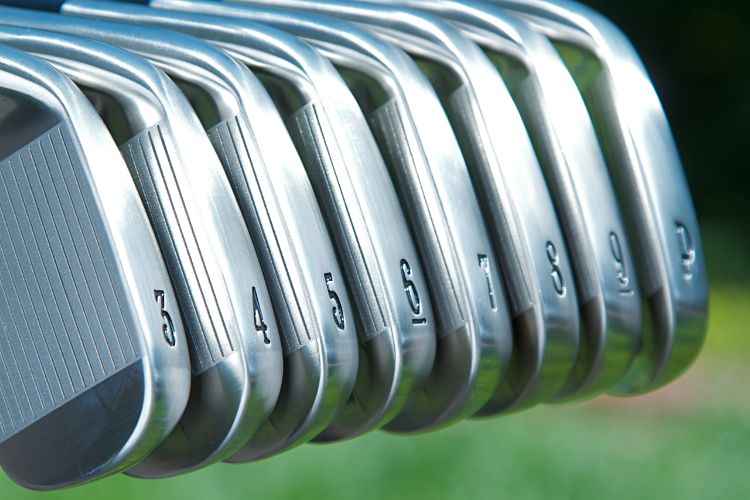
Knowing your gear is just as important as understanding your shots.
Here are some key equipment terms you’ll need to know:
Driver:
The longest club with the largest head, used for tee shots to achieve maximum distance. It’s designed to help you cover a lot of ground quickly.
Iron:
A versatile club used for a variety of shots. Irons are numbered 1 to 9, with higher numbers offering more loft and shorter distances. They’re essential for everything from approach shots to fairway play.
Wedge:
A specialized iron with a high loft used for short approach shots, chips, and bunker play. Types include pitching wedges, sand wedges, and lob wedges. Wedges are great for precise shots that need to rise quickly and stop fast.
Putter:
A club used on the green to roll the ball into the hole. With a flat face and a smooth stroke, the putter is all about control and precision.
Hybrid:
A mix between an iron and a wood, hybrids replace longer irons and are easier to hit. They offer more loft and forgiveness, especially when dealing with tough lies.
Fairway Wood:
A club designed for long-distance shots from the fairway. Common ones include the 3-wood and 5-wood. They’re made to cover much distance with a higher trajectory than the driver.
Knowing your equipment helps you choose the right club for each shot. Understanding how each club works and how it affects the golf ball’s flight can make a big difference in your performance.
At Skillest, our coaches always emphasize the importance of getting familiar with your clubs to help you optimize your game.
Advanced Golf Terms to Enhance Your Game
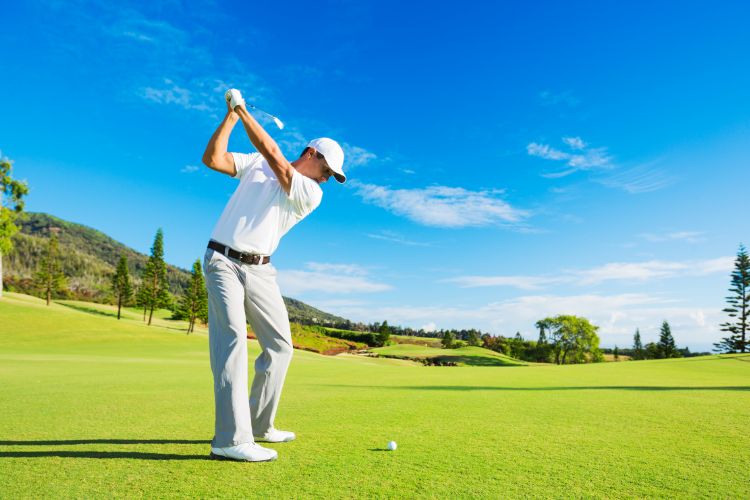
As you get more comfortable with golf, you’ll start to encounter some advanced terms that revolve around strategy, technique, and managing the course.
Getting familiar with these concepts will deepen your understanding of the game and help you take your play to the next level.
Swing and Technique Terms
A consistent golf swing is the foundation of a great game, and these advanced terms focus on improving that swing and your overall technique:
Backswing:
This is the part of the swing where you take the club away from the ball. A smooth backswing is key to setting up the rest of your swing. It involves turning your shoulders and hips while maintaining your balance—setting the stage for a successful shot.
Downswing:
This is the motion where you bring the club back down to strike the golf ball. Timing and speed are crucial here, affecting your shot’s accuracy and power. A good downswing starts with your hips and legs, letting your arms follow through in a coordinated motion.
Follow-through:
After striking the ball, the follow-through is the continuation of your swing. It’s crucial for balance and making sure your shot stays smooth and controlled. A solid follow-through shows that your swing was executed correctly and you’re staying in rhythm.
Lag:
This refers to maintaining an angle between your club shaft and lead arm during the downswing. It generates power by delaying the release of your wrists until right before impact, helping you increase club head speed and distance.
Overlapping Grip:
A common grip where the pinky of your trailing hand overlaps the index finger of your lead hand. The overlapping grip helps create a more unified connection between your hands, and many pro golfers prefer it for control and precision.
Shank:
This is when the ball is struck by the hosel (the neck of the club), causing it to veer off to the side. Understanding why shanks happen can help you adjust your swing—common causes include standing too close to the ball or having an outside-to-in swing path.
Knowing these terms will help you analyze and refine your swing. Focusing on your technique and mechanics helps improve your consistency and accuracy.
Many coaches use video analysis to break down these elements and give you feedback, helping you make the right adjustments.
Course Navigation Terms
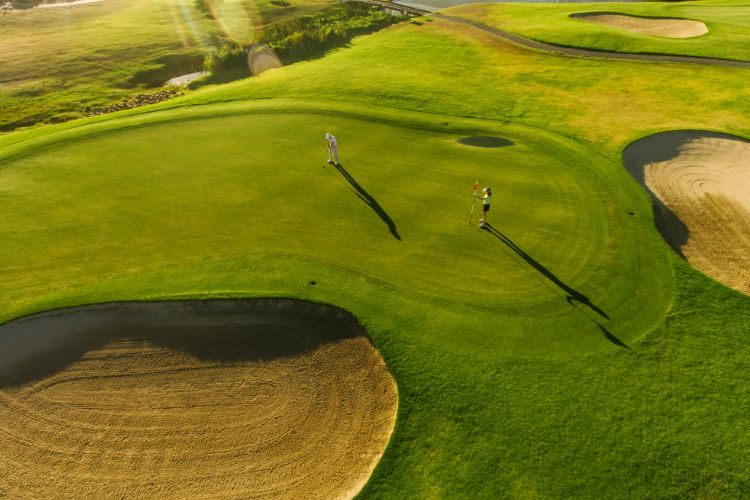
Navigating the course involves more than just hitting the golf ball—it’s about strategy and making smart choices based on the hole’s layout.
These terms will help you think strategically on the course:
Dogleg:
This is a hole that bends left or right, resembling the shape of a dog’s leg. You’ll need to think carefully about how to play doglegs—whether you go for the safe route or try to cut the corner for a shorter approach.
Hazard:
Hazards are areas like bunkers (sand traps) or water that add an extra challenge to your shot. Managing your risks when you’re near hazards is important—sometimes, you’ll play more conservatively to avoid trouble, and other times, you’ll go for it if the conditions are right.
Carry:
This refers to the distance your ball travels through the air before it hits the ground. Knowing your carry distances helps you pick the right clubs for shots, especially when needing to clear obstacles like bunkers or water.
Blind Shot:
A shot where you can’t see the area where the ball will land, like when you’re shooting over a hill or through trees. It’s important to trust your distance and alignment, relying on your experience to pull off the shot.
Lie:
The lie is the golf ball’s position on the ground. A “good” lie means the ball is sitting nicely for a shot, while a “bad” lie means it’s in rough terrain or buried in sand. Knowing your lie helps you decide what kind of shot to take and which club to use.
Yardage:
This is the distance from your current position to a specific target on the hole, like the green. Accurate yardage helps with shot decisions, allowing you to choose the right club and plan your approach. Many golfers use rangefinders or GPS devices to get precise measurements.
Mastering these terms allows you to navigate the course more confidently and make better decisions. Using the right tools and working with a coach can help sharpen your course management skills, leading to smarter play and potentially lower scores.
Fun and Slang Golf Terms
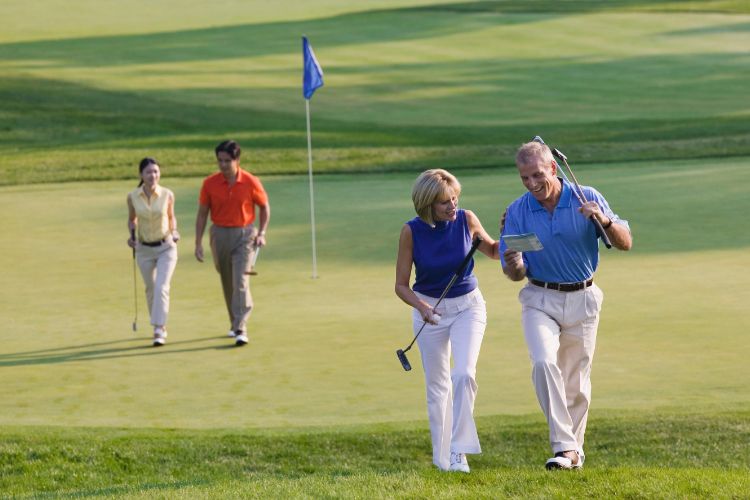
Golf isn’t just about technique and precision – it’s also about enjoying time with friends, having fun, and embracing the quirky side of the game. Learning some of these fun golf slang terms can add a little more personality to your rounds and help you connect with fellow golfers.
Plus, they can bring some much-needed humor to the ups and downs of the game!
Popular Slang Used on the Course
These terms are common in casual rounds and can bring some laughs along the way:
Mulligan:
This is a do-over shot, often given on the first tee. It’s not part of the official rules, but in friendly games, it’s a chance to take a second swing without penalty. A great way to start fresh!
Sandbagger:
A golfer who intentionally plays below their ability to manipulate handicaps. This term is usually used either in a humorous or critical way, reminding players to keep things fair.
Snowman:
Scoring an eight on a golf hole – the shape of a snowman. Definitely not the goal, but it happens! Usually comes from a tricky hole or a series of unfortunate shots.
Fried Egg:
When your ball is half-buried in a bunker, making it look like a fried egg. It’s tough to escape from, but you can make it work with the right bunker skills!
Hosel Rocket:
Another way of saying you shanked the ball. The ball shoots off at a sharp angle, often sending it into a completely different direction. A source of frustration and humor for many golfers.
Lip Out:
When your golf ball circles the edge of the hole but just doesn’t drop in. That close-but-no-cigar moment that tests your patience and reminds you golf is full of surprises.
These fun terms can break the ice and help you bond with new golfing buddies. They add a relaxed vibe to the game and remind you not to take everything too seriously.
Humorous Golf Sayings

Golfers love their witty sayings. These little nuggets of wisdom (or humor) can help you keep things light, even when the game isn’t going your way:
“Drive for show, putt for dough”: It’s easy to get caught up in hitting long drives, but at the end of the day, it’s your putting that gets you the scores. A reminder that your short game is just as important as the big drives.
“It’s not the clubs; it’s the swinger”: A great reminder that your skill matters far more than the gear you’re using. Focus on your technique and practice, and the results will follow.
“A bad day at golf beats a good day at work”: No matter how badly the game goes, it’s still better than sitting at your desk! This saying celebrates golf as a way to unwind and enjoy some time away from the daily grind.
“Let the big dog eat”: A fun saying encouraging you to go for a powerful, confident drive. Let your driver loose and take that shot with some authority!
“You’re still away”: A playful reminder that your opponent’s ball is still farther from the hole than yours, even if their shot seemed good. It adds some lighthearted competition to the game.
These sayings remind us that golf doesn’t always have to be serious. Whether celebrating a great shot or laughing off a mistake, embracing the humor in golf can make the game much more fun.
By using these phrases, you’re adding some good-natured spirit to the round and creating some fun memories with your golfing pals.
Building Your Golf Vocab
Getting familiar with golf terms is a huge step towards becoming a more confident and skilled player. The language of golf is packed with everything from scoring and equipment to techniques and slang.
Understanding these terms doesn’t just help your gameplay – it makes you appreciate the sport on a deeper level. With this knowledge, you’re laying a solid foundation for growth, which means more satisfying rounds and a real sense of accomplishment.
But don’t forget, knowing the terms is just one piece of the puzzle. Practice, patience, and a bit of coaching are just as crucial to improving. If you want personalized guidance, consider connecting with a coach through Skillest, the world’s leading sports coaching platform.
With expert coaches who tailor their advice to your goals, you’ll be on your way to taking your game to the next level.
So, the next time you step onto the course, do it with confidence! With your new golf vocabulary, you’ll be able to tackle the challenges, celebrate the wins, and enjoy all the great moments golf brings.
Frequently Asked Questions (FAQs):
What are golf terms and their meanings?
Here are a few common golf terms you might hear:
- Dance floor: The green, where the hole is located, and the grass is mowed short for putting.
- Draw: A shot that curves from right to left for right-handed golfers.
- Drive: The first shot from the tee, usually with a driver for distance.
- Driver: The longest club with the biggest head, used for tee shots.
- Duff: A poorly hit shot where the club hits the ground before the ball, resulting in a weak shot.
What is the 90% rule in golf?
The 90% rule is a guideline for shot distance. It suggests that you should hit the golf ball at least 90% of the way to your target.
For example, if you’re 100 yards from the hole, aim to hit the ball at least 90 yards. This rule helps you choose the right club and encourages full, committed swings.
What are the 7 golf scoring terms explained?
Here are some key golf scoring terms:
- Albatross/Double Eagle: Three strokes under par – very rare and impressive.
- Condor: Four strokes under par – the rarest score in golf, usually a hole-in-one on a par-five.
- Ace/Hole-in-One: Completing a hole in one shot, often on a par-three.
- Eagle: Two strokes under par – an excellent achievement.
- Birdie: One stroke under par – a goal for many golfers.
- Par: The expected number of strokes to finish a hole.
- Bogey: One stroke over par – common for many players, especially amateurs.
What is rule 5 in golf?
Rule 5 covers when and how to play a round of golf, including:
- Where and when you can practice on the course before or during your round.
- When your round starts and ends.
- What happens when play must stop or resume.
